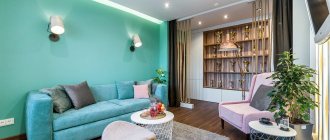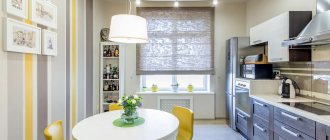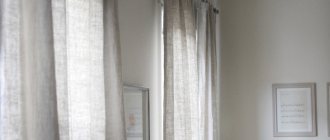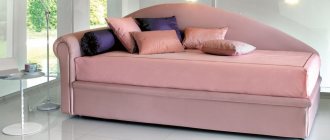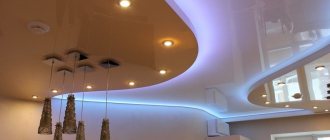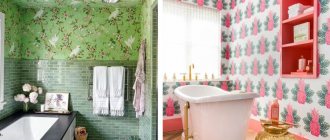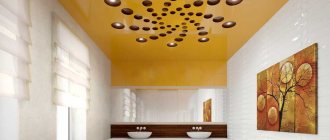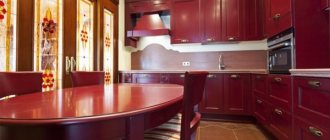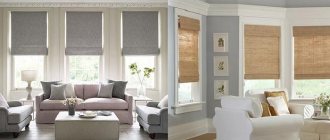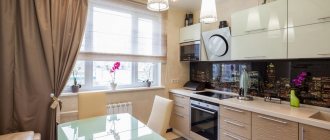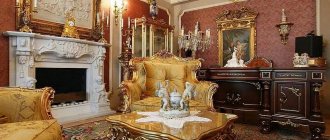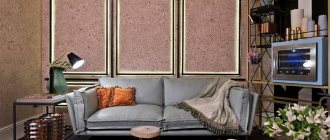Description, operating principle, fuel
What is a biofireplace?
A biofireplace is a modern and safe interpretation of a fireplace without a chimney, which can be used in almost any room, which is undoubtedly an advantage.
How does it work? The biofireplace runs on biofuel, which consists of biological raw materials, and the combustion products are no more harmful than those from a paraffin candle. Externally, a biofireplace can resemble the classic version or be a modern design that will decorate a fashionable interior.
The photo shows a stylish living room combined with a dining area. A double-sided fireplace not only performs a decorative function, but also helps to zone the space of the apartment.
Operating principle
The principle of operation is quite simple. Fuel is poured into the fuel tank and ignited with a lighter. To get fire, these two actions are quite enough. For safety and slow evaporation of fuel, ceramic wool is used.
Fuel for biofireplace
The fuel is technical alcohol. The consistency can be different, for example gel or liquid. To obtain biogel, alcohol, water, thickener and salt are added to the composition. The liquid form of fuel is obtained by processing agricultural crops.
Fuel consumption is quite economical, on average 0.5 liters per hour and a half of operation. But consumption may vary depending on the features of the selected model. The combustion temperature of the flame itself depends on the selected fuel, on average it is 400-600 degrees.
Does the bio-fireplace heat, heat transfer?
Biofireplaces, in addition to aesthetic pleasure, also provide warmth. The heat output of different models differs, starting from 1 kW and can reach 10 kW. In terms of heat production, a biofireplace can be compared to an electric heater. Small fireplaces most often do not have a heating function.
Do you need an outlet?
There is no need for electricity to operate. A natural flame is formed during the combustion of fuel.
Requirements for the room in which the biofireplace is installed
The biofireplace does not have any special requirements for placement, however, basic precautions must still be observed.
- The room in which the bio-fireplace is installed should be well ventilated, but not have strong drafts, just like fans and air conditioners.
- The distance from any interior items should be at least a meter, and from flammable objects such as paper or textiles, at least one and a half meters.
The photo shows a minimalist living room decorated in black and white and a long bio-fireplace.
Traditional, automatic and semi-automatic
The difference between traditional, automatic and semi-automatic biofireplaces is in control technology.
- A traditional, or in other words, mechanical fireplace is lit manually, using matches or a lighter.
- The automatic fireplace is controlled remotely by phone, tablet or remote control.
- The semi-automatic model begins and ends its work after a command given through the control panel located on the fireplace itself.
Open and closed
The difference between open and closed type is in the design of the fuel tank. The open type allows you to see the amount of liquid inside, while the closed type “hides” the firebox inside the structure box.
Placement in furniture
Another large group of devices that I would also like to talk about are biofireplaces built into furniture. These devices are usually used in small rooms in which the owners want to create unique comfort, warmth, and an excellent aura for relaxation.
Small table with built-in bio-fireplace
In most cases, biofireplaces are built into the horizontal surface of furniture, for example, into the top of small coffee tables and large family tables.
This is the optimal location for a small fire system that uses a low-power burner whose fuel block is designed to hold fuel in the range of one liter. The average burning time of such devices is 2-3 hours.
Placing a bio-fireplace in a table allows you to see with your own eyes the beauty of natural fire, without compromising the functionality of the furniture. You can also place objects on the table without fear of burning them, because the flame is surrounded by a fireproof glass screen that prevents it from escaping. On some models the glass dome is removable. This is done for ease of cleaning and refueling the system.
Often, biofireplaces are built into cabinet furniture for the living room and kitchen. In these cases, the bio-fireplace also does not interfere with the functionality of the furniture, but adds a unique flavor to it. This placement is especially effective in small rooms, where space is at a premium, but in large dining rooms or living rooms such a location of the fire system is quite justified.
Original design of the coffee table
The presence of a biofireplace in furniture is quite safe, largely because the device is equipped with special sensors that monitor the operation of the system, the level of fire and its intensity. If unexpected situations arise, the sensors simply turn off the biofireplace. However, you should still not place flammable materials, such as thin synthetic fabrics, wool or paper, next to it.
Good to know: Corner bio-fireplace, its advantages and use in the interior
Design
How is the fireplace constructed? The design of the case can be almost anything, depending on personal preferences. The main requirement is compliance with safety rules, or rather the required minimum distance from the flame. The top of the flame should be at least 80 cm from the surface of the body, and the distance from the side should be at least 20-25 cm.
Types and diagrams of burners
As for the description of the burners, they can be of several types and have different characteristics, but they all operate on the general principle, evaporative atmospheric. That is, the fuel evaporates in a heated chamber in the absence of air, and the vapors released into the atmosphere burn in the air.
For this operating principle, there are three types of burners:
- capillary,
- wick,
- gravity flow.
The capillary burner has a simple design, but there are a number of disadvantages. When starting up, you may smell ethanol; the filler in the burner tank becomes clogged over time and requires replacement, and it is also necessary to provide a barrier and adjust the flame height, since at the beginning of operation the fire burns hotter.
The wick burner is easier to use. Filling the container with fuel is done “by eye”. The flame of this type of burner is stable, without sudden changes, so a barrier is not required, except for various flame effects, but it is worth providing for the presence of a divider grille.
A gravity burner produces a stable flame during operation and does not emit vapors when warming up, since a supply of them is formed in the evaporator and this is enough to start. In addition, this type of burner can be produced in a round shape, provides long operation, up to 4 hours, and is also suitable for a fireplace of any power.
Advantages and disadvantages
A biofireplace, like any other device, has its advantages and disadvantages. It is worth noting the most significant of them.
Pros:
- The biofireplace is easy to install and operate;
- In addition to its decorative function in the interior, a biofireplace is an additional source of heat;
- Economical fuel consumption and low cost;
- Wide selection of models;
- Combustion products are not harmful to health.
Minuses:
- High cost, especially on models with automatic control;
- Open fire requires careful handling.
The photo shows a spacious living room in high-tech style. A freestanding floor-standing fireplace replaces the coffee table, and the flames can be seen from anywhere in the room.
What types of built-in biofireplaces are there?
A built-in bio-fireplace is often installed and placed in various furniture, which in turn allows you to profitably save free space; this option will be an ideal and winning solution for those who have rooms with small and limited space and want to use it as rationally and profitably as possible.
Before you buy a biofireplace, you need to choose a room and a specific furniture set for its installation - it must be a horizontal plane or surface. Also, for mini built-in models, the optimal placement location would be a small cabinet or a large dining table opposite. Such fireboxes are not very powerful and, as a rule, their tank is filled to one liter, which allows the fire to burn for about 2-4 hours continuously.
A biofireplace in furniture can be made in a certain style and with cladding in the form of:
- Stone;
- Brick;
- Ceramics;
- Iron.
Also, this design can be complemented by a decorative firewood rack, which makes the models even more similar to classic solid fuel designs.
A bio-fireplace in the wall is another one of the most popular options today; this method of embedding a heating unit allows you to place fireboxes absolutely anywhere in the room and even several units simultaneously next to or at different ends of the living room, bedroom, office. Often, bio-fireplaces are placed along the walls in restaurants, cafes, hotels and bars; this option attracts attention and makes the interior even more expensive, stylish and sophisticated.
Biofireplaces are a profitable and innovative design solution that is used and used quite often, however, in addition to built-in ones, the following fireplace options according to their location are very popular and in demand today:
- Floor;
- Tabletop;
- Corner;
- Hanging.
Suspended structures are also built-in; just depending on their type, they can simply be fixed on a wall or partition using a holder, or installed and built into an insulated hole or niche prepared for them.
Installing a hanging bio-fireplace is quite simple and does not require complex manipulations; this variation is attached to the wall like a simple TV and is often placed in living rooms. Installing a built-in bio-fireplace is much more difficult; it requires cutting a hole in the furniture set, insulating it, and only then placing the fireplace hearth itself.
A bio-fireplace built into a wall can have different shapes, from classic rectangular and square to round, which fits perfectly with trends such as modernism and minimalism. Triangular biofireplaces, in turn, are ideal for living rooms and other rooms designed in high-tech style.
Before you buy a built-in biofireplace, you need to familiarize yourself in more detail with all the requirements and features for choosing and installing such a modern fireplace. For example, a room for installing a built-in model with classic dimensions must have good ventilation, large windows and sufficient area, which will be at least 25 square meters.
For a small room with an area of up to 20 square meters, the ideal solution would be a miniature tabletop model or a small built-in fireplace in a furniture set such as a table or bedside table. If necessary, you can buy a ready-made version of a biofireplace in the store with a suitable portal or piece of furniture, which will allow you to save time and money on installation and designer services.
If you want to use the services of a designer, remember that the design of your bio-fireplace must necessarily consist of the following structural elements:
- The frame, due to which all parts of such modern equipment are connected and interlocked;
- The bio-fireplace tank is located in the inside of the heating equipment and is intended for filling fuel;
- The burner of a built-in bio-fireplace is equipped with protective partitions, which are often represented by transparent tempered glass on a fire-resistant basis, through which the flame is clearly visible.
The strongest, most reliable and durable frame is assembled from vermiculite, and in order for the biofireplace hearth to be ideally installed in a specific furniture set, it is important to initially select it based on parameters such as width, height and depth.
Built-in eco-fireplaces can be equipped with a fuel tank of certain sizes, which determine the time and duration of fire burning, for example, the minimum burning time is considered to be a time period of 2-4 hours. On average, the burning time of a biofireplace fire is about 4-7 hours, but the time can be extended by pouring bioethanol into the tank. Many models also allow you to manually adjust the height and intensity of the flame; the maximum fire height will be about 200-300 millimeters.
Protective walls made of tempered fire-resistant transparent glass are necessary if you are using the fireplace, however, when cleaning or refueling the fuel tank, they are removed and allow you to quickly and easily carry out these manipulations.
Kinds
Tabletop (portable)
Mobile design that can be easily moved to another room. This model produces a minimum of heat and has more of a decorative function in the interior of the room. Mini biofireplaces operate on replaceable cartridges.
Built into a niche in the wall
An interesting model can be built into one or two vertical planes, that is, a corner biofireplace. Visually, the structure looks like part of a wall.
The photo shows the interior of a cozy living room in white and gray. A rectangular bio-fireplace built into the wall fills the room with warmth.
Built into furniture
A fireplace built into the furniture takes up little space, but creates a feeling of coziness in the interior. A mini bio-fireplace can be built into a coffee table. As a rule, it is installed on a flat horizontal surface. The table is easy to move and will give uniqueness to the interior. Another design option is a fireplace built into the countertop or central part of the cabinet.
The photo shows the interior of a bright living room in a modern style. The bio-fireplace is built into the chest of drawers, the back wall of which is decorated with mirror inserts.
Wall
The narrow design does not take up much space and, depending on the design, will decorate the interior in a modern style. The wall-mounted model is fixed to the wall with 2 screws.
Floor
A biofireplace of this type can be considered not part of the interior design, but its main object. Unlike wall-mounted and built-in models, a floor-mounted biofireplace provides a full view of the hearth from any side. Floor-standing models are heavier, but just as portable.
Suspension
The bio-fireplace is attached to the ceiling. This model will look good in rooms with high ceilings and will decorate a modern interior.
In the portal
The bio-fireplace in the portal imitates a fireplace in the classical sense. The portal itself can be made of various materials and is of the wall type. The depth and width of the portal depends on the size of the fuel cassette.
The photo shows an interior in a classic style. The bio-fireplace is “recessed” into the portal, and the body is made of stone and plaster.
Angular
The corner model can be installed in the corner of the room, thereby using empty space. Another type of corner fireplace is installed on the walls, so it can decorate two rooms at once.
Round
A round or spherical biofireplace is suitable for modern interior design. A round fireplace will look good as a hanging, floor or tabletop model.
Types and possibilities of application
There are several types of biofuel fireplaces:
- stationary - have impressive dimensions and weight, divided into wall-mounted and island versions;
- mobile – there are desktop and floor-mounted options;
- built-in - they are installed in a special niche in the wall or furniture;
- wall-mounted – have a flat-shaped body, they can be mounted on wall structures made of various bases, including brick and plasterboard;
- suspended - the tubular base is fixed to the ceiling, and the body with the burner will be at a height of 0.7-1 m from the floor;
- corner - there are built into the inner or outer corner of the wall, floor and wall.
The photo shows a minimalist style interior
Compact mobile units are characterized by low power and work as a decorative element with a fascinating play of flame. Island models of eco-fireplaces are often a powerful device that can also function as a heater.
Built-in
The fireproof housing with tempered glass front panel is built into various bases:
- into a niche in the wall. It can be a corner structure, a linear model of a rectangular or square shape, or with a figured contour;
- into the tabletop. There are options built into a stone or glass countertop, while the heating unit is equipped with a tempered glass panel;
- into furniture. The basis for building a biofurnace can be shelves, cabinets, or a chest of drawers.
Attention! To install the equipment, it is necessary to prepare a niche and cover the surface with fire-resistant fabric.
Floor-standing
A wall-mounted bio-fireplace in the interior of a home is an effective imitation of a real hearth. The design most often involves a traditional square or rectangular portal with blank ends and front glass protection.
The island model can be installed in the center of the interior composition, providing visibility from anywhere in the room. Versions in the form of art objects of various shapes and sizes are trending. An eco-fireplace island with an imitation of a classic portal is often used to zone functional spaces in a living room or hall.
Tabletop
The devices are characterized by compact shapes and mobility. They can be placed on any horizontal surfaces. Tabletop modifications of the device with live fire are in demand in the design of small rooms, when, due to the small square footage, it is inappropriate to use floor-standing analogues.
Attention! When choosing a small tabletop fireplace, it is important to ensure there is a tip-over protection mechanism.
In the photo there is a biofireplace in the apartment design as a stylish accent
Wall mounted
Often, wall-mounted versions of a biofuel fireplace resemble the original painting. The designs are characterized by flat shapes, the standard length varies between 50-100 cm with a depth of about 15-20 cm. If desired, you can custom-make a large-sized model in 3D format with 3 viewing angles. in the form of a panel with a live fire behind a glass panel looks impressive in the interior
Materials, body design
Glass
The stylish design with glass will look harmonious in a modern interior. In addition, the glass gives a complete view of the flame. The body uses reliable heat-resistant glass.
Ceramic body
This type is most often used in the manufacture of small structures, such as a tabletop biofireplace. Ceramic matches the flame beautifully. The design of the body can also be made of ceramic tiles.
With a plasterboard portal
Plasterboard construction is a fairly economical design method. You can make the design yourself or purchase a ready-made one. The size, shape and finish can be almost any.
Marble body
A bio-fireplace in a marble casing is a luxurious and expensive piece of furniture. Natural marble or high-quality imitation will look perfect in any interior.
Wooden body
Wood is a beautiful and noble material. The design can be in classic, country or Provence style. The wood must be treated with a heat-resistant coating.
What is a biofireplace
The design features and operating principle of the biofireplace are interconnected. The basis of the device is a conventional burner made of stainless steel. But since the biofireplace is not used to heat the living room, but only performs a decorative function, the power of such a burner is minimal.
In design, the device most closely resembles an ordinary alcohol lamp: a small container contains fuel - alcohol, bioalcohol, gel, dry alcohol. When the fuel burns, the flame exits through the burner slot. Since the fuel is supplied in very small portions, the fire never gets too hot.
The second part of the fireplace is the frame. It is made from fireproof or heat-resistant materials and, as a rule, has a wide variety of shapes. The frame prevents contact of the burner with surrounding objects and to some extent limits the access of oxygen, especially in large models.
A distinctive feature of a bio fireplace from a working fireplace is the absence of a chimney. The fuel for it is pure alcohol, and it burns without releasing soot. Since the burner power is low, combustion produces such a small amount of carbon dioxide that no special smoke exhaust system is required to remove it from the house.
In the interior of the living room, the biofireplace plays the role of a central element. The living flame and beautiful design of the bio-fireplace itself distracts attention even from the TV. Therefore, it is so important to correctly place the device in the living room and choose its size and shape.
Accessories and decor
Accessories and decorative elements will add ambiance and create the right atmosphere in the interior. It is worth remembering that the decor should not block the flame, but should be located around the fuel block.
Ceramic firewood, burnt logs
An integral part of the fireplace can be considered red-hot wood or stones; they enchant with their warmth and mesmerizing color. For a bio-fireplace you will have to exclude natural wood. It will be replaced by ceramic products, which are practically indistinguishable in color and texture from real wood. Ceramic firewood can imitate any species, most often pine or birch.
Imitation coals
Biofireplace coals are made of ceramics or glass ceramics. Visually, they are no different from the real ones and exactly repeat the shape and color.
Stones, pebbles
Natural pebbles or stone are used. The material is strong and heat resistant. For a more attractive appearance, the stones are polished and coated with the desired color. The fire is reflected especially beautifully on the varnished surface of the stone.
Photo in the interior of the apartment
Living room
A fireplace in the interior of the living room will envelop the room in special comfort and fill an ordinary evening with charm. Different variations of location and design allow you to choose the ideal option for your living room interior. For example, a floor-standing fireplace in a glass case for a modern style or in a portal with a marble frame for a classic one.
A big advantage of a bio-fireplace is the ability to use the space above the fireplace, for example, installing a TV above it. This design method is safe and looks impressive.
The photo shows a modern living room interior with a bio-fireplace built into the countertop.
Bedroom
A fire in the bedroom interior will help you relax and give you a romantic mood. For a spacious bedroom, you can use a built-in or floor-standing fireplace. For a compact room, desktop or built-in furniture models are suitable.
Kitchen
The fireplace in the kitchen interior is an unusual and original solution. It can be built into a wall, the end of an island, or serve as a room divider. Another design option would be a small tabletop fireplace that will decorate the dining area.
Loggia, balcony
A loggia or balcony will become a real lounge area, even with a small bio-fireplace. The interior will be complemented by a table and a pair of cozy chairs. On such a loggia it is pleasant to end the day under the warm glow of the fire.
Features of selection and operation
Although the biofireplace in the living room serves only a decorative role, when choosing it, it is worth considering not only the design and style of the model.
- First of all, determine its type of mounting : floor, tabletop, wall-mounted, built-in. If you can ask for a floor-standing one to be installed anywhere in the living room, then for a built-in one you will have to make a niche in the wall.
- Depending on the location, the dimensions are determined. Desktop models, in principle, are not large. But the sizes of wall ones vary very widely. A simple hanging bio-fireplace is usually small, but a built-in model can have very impressive dimensions.
- Type of fuel - ethanol, biomethanol, dimethyl ether and even dry alcohol are used in this capacity, that is, materials that can burn without the formation of soot. The choice is determined only by the preferences of the owner, since different types of fuel do not have any advantages over each other.
- Flame color - ethanol burns with a completely blue flame, in the literal sense of the word. This shade looks unnatural, especially in a large bio-fireplace. To get a natural-colored fire, you should choose a model that can operate on fuel with coloring additives.
- Fireplace type - in a closed bio-fireplace, the front wall is covered with glass. It is not available in the open model. The type of fireplace affects the placement: a closed model can be installed anywhere in the living room, an open one is located no closer than 1 meter to the ceiling.
- Although a biofireplace requires a very small amount of air, it is still necessary to take into account the living room area and the power of the burner. In a small room, only a tabletop or wall-mounted bio fireplace of modest size is acceptable. In the living room of more than 25 sq. m. you can install a large built-in or floor-mounted one, but in this case additional air flow will be required - ventilation, for example.
- Control technology. A traditional mechanical living room fireplace is lit manually using long matches. The automatic model is controlled from a remote control. The semi-automatic device is turned on and programmed using the control panel located on the body of the bio fireplace.
- Design . A biofireplace in a modern-style living room is most often made of metal and glass or glass and stone. Classic models imitate brick and natural stone.
Photo in a country house
A country house or cottage is an ideal place for a fireplace. The large area allows you to choose unusual and voluminous models, while eliminating unnecessary hassle during melting and maintenance.
The photo shows a cozy lounge area of a country house. The bio-fireplace is imitated as a wood fireplace.
Another original solution would be to install a fireplace outside, a couple of chairs opposite it and a cozy blanket will make an evening in the fresh air truly magical.
Biofireplaces as part of the living room interior
The bio-fireplace in the living room interior claims first place. A living flame and unusual design transform a purely decorative detail into a symbol of home comfort and serenity. As a result, the biofireplace becomes a competitor to the TV.
They solve this problem depending on the size of the living room and the dimensions of the model.
- In a large living room you can organize several zones. In one of them the center will be a bio-fireplace, in the other - a TV. This option is allowed in modern styles: constructivism, hi-tech or minimalism, Scandinavian style - in any concept where the living room is supposed to be divided into zones of different sizes.
Classics exclude this option - here it is extremely important to maintain central symmetry. Again, in a large living room, this feature can be used: install an island model approximately in the center, and mount the plasma screen on the wall. Thus, the bio-fireplace and TV in the living room interior cease to be competitors.
- In a small living room, such a division is only possible when installing a tabletop model. If the bio-fireplace is chosen to be floor- or wall-mounted, use the only correct option: install a bio-fireplace under the living room TV.
The installation method is determined by the convenience and style of the living room. With a classic design or even modern design, preference is given to traditional floor models. In this case, a certain ratio is observed: the width of the fireplace screen approximately coincides with the width of the TV screen. In modern styles, a built-in model is installed. Its dimensions may be slightly larger.
The photo shows a modern style of decorating a living room with a bio-fireplace and a TV.
Presentation in different styles
Classical
The interior will be decorated with a bio-fireplace in a portal framed with a marble or plasterboard frame. Symmetrical shapes and straight lines will support the design concept.
Modern
There are many design ideas for a modern interior. A biofireplace will be an excellent solution for such trends as minimalism or hi-tech. A transparent glass, chrome or ceramic body will highlight the style features in the interior.
The photo shows a living room in a modern style, made in a warm palette. A small fireplace built into the wall decorates the interior.
Loft
The urban direction will be decorated with a bio-fireplace built into the wall or hanging. Fire will pair well with cold, raw concrete walls or brickwork.
The photo shows an interior in loft style. A small fireplace is located under the TV and takes up minimal space.
Provence
Gentle and romantic Provence will envelop the room in warmth with a bio-fireplace in a wooden, stone or plasterboard casing. The interior will be complemented by ceramic birch firewood and coals.
Options for implementation in the interior
When choosing an eco-fireplace model, it is important to take into account the interior style and operating features.
Classic
Floor-standing versions fit well into the design of a classic living room. Most often, a wall-mounted model is used as a successful alternative to a traditional fireplace. If you choose an island hearth, it is important to follow the rules of symmetry when creating an interior composition. Smooth lines and symmetry of shapes should also be present in the design of the portal.
As a rule, a biofireplace in the interior of a classically designed apartment is the central element and sets the tone for the entire composition. Below are illustrations with examples of using a fireplace in the living room.
Provence
For a provincial style, a bio-fireplace in a body made of bleached wood, a model in plasterboard or tiled design, is suitable. A stone facade or brickwork with aged whitewash looks good.
Modern
A non-standard model in the form of a burner mounted along the corner under a brick wall will harmoniously fit into the modern concept. Make a choice in favor of unusual shapes if tabletop or floor-standing equipment variations are a priority. Eco-fireplaces in the Art Nouveau style also feature mirrored surfaces.
